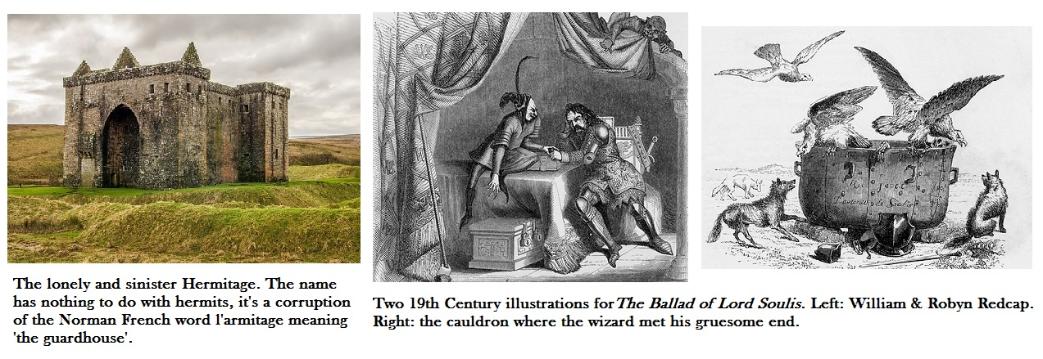BLACK ARTS AND RED CAPS – THE SECRET HISTORY OF HERMITAGE CASTLE
The remote and forbidding fortress of The Hermitage, in the Scottish Borders, is best known as the location of a rendezvous between Mary Queen of Scots and her lover the Earl of Bothwell but this romantic tale hides a much darker history.
The castle was built c.1240 to protect the strategic valley of Liddesdale from the English but one of the first Lords of Hermitage, a Scots-Norman knight named de Soules (or Soulis), was such a cruel tyrant he was murdered by his own servants. During the First War of Scottish Independence (1296-1328) the Hermitage was owned by another de Soules, William II, who had a claim to the throne occupied by his bitter rival Robert the Bruce. This would certainly justify a need for such a strong castle but the locals had a different explanation: William de Soules was a wizard.
In the taverns of Liddesdale, the gossips whispered that William had learned the secret of the Black Arts from the famous warlock Michael Scott and that he could summon the Devil by banging three times on a magic iron chest. This chest was kept in a secret chamber beneath the Hermitage’s massive ramparts and here William also cast spells to protect himself from his enemies. Weapons made of steel could not harm him and ropes made of hemp could not bind him; William was even seen in the company of an evil demon named Robyn Redcap.
Redcaps were a common feature of Borders’ folklore. Usually depicted as a deformed old man with glowing eyes and sharpened teeth, redcaps lived in ruined castles and preyed on unwary travellers, draining their blood to dye their caps. Redcaps had to kill frequently because they died if the blood in which their caps were soaked ever dried out.The favourite weapon of these malevolent sprites was a long pike and though they wore iron boots it was impossible for mortals to outrun a redcap.
Before long rumours began to circulate that William was kidnapping children and young maidens to use in his evil rites so the locals petitioned Robert the Bruce to do something about this monster in their midst. The king duly sent a messenger to warn William to mend his ways but the man never left the castle. Some say the hapless herald was walled up alive, together with his horse, in one of The Hermitage’s dungeons.
This blatant flouting of royal authority prompted The Bruce to declare: “Boil him, if you please, but let me hear no more of him!” The men of Liddesdale were happy to take matters into their own hands but how could they kill a man who could not be cut down by swords or bound with ropes? According to legend, a man named True Thomas came to their rescue. Thomas dug up a spellbook that had been buried with the wizard Michael Scott, William de Soules’ teacher, and this grimoire revealed the secret of defeating witches and warlocks: they had to be boiled in lead.
Emboldened by this knowledge, the men of Liddesdale ambushed William near an ancient stone circle called Ninestanes Rigg (Nine Stones Ridge) and wrapped him in lead before he could use his occult powers. With his magic neutralised, William was dragged into the centre of the circle and boiled alive. In the words of the famous Border Ballad by John Leyden (1775-1811):
“They roll’d him up in a sheet of lead,
A sheet of lead for a funeral pall;
They plunged him in the cauldron red,
And melted him, lead, and bones and all!”
Sir Walter Scott also recorded William’s terrible fate in his 1802 anthology ‘The Minstrelsy of the Scottish Border’ and whilst Scott’s version may be the stuff of legend, the real William de Soules was involved in a plot to assassinate Robert de Bruce and died, in mysterious circumstances, shortly after his arrest and imprisonment in 1320.
True Thomas was one of the inspirations for Thomas Devilstone, the necromancer, soldier of fortune and hero of my Tudor novel The Devil’s Band. Read the first 1000 words on my Facebook page: https://www.facebook.com/thedevilstonechronicles/book_preview
